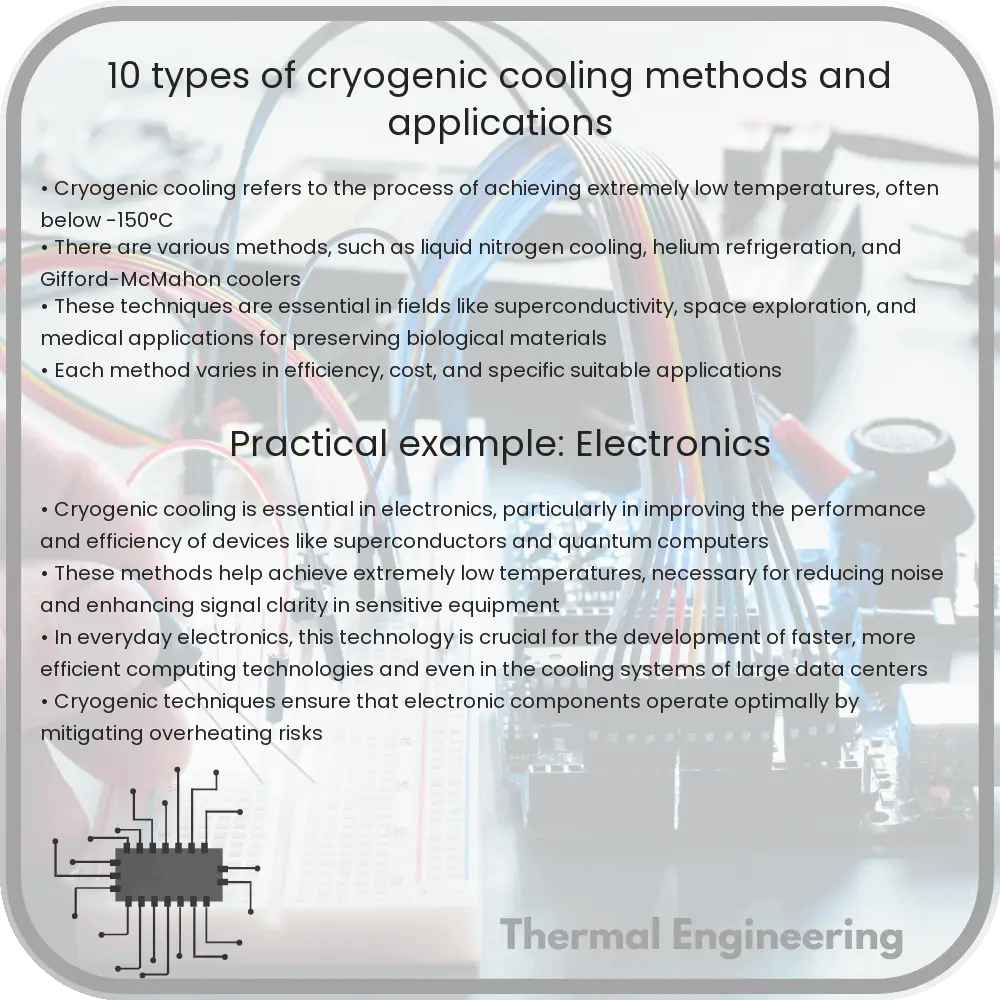An in-depth exploration of cryogenic cooling, detailing methods like Joule-Thomson and Brayton Cycles, and its diverse applications from scientific research to industrial uses.

Understanding Cryogenic Cooling: Methods and Applications
Cryogenic cooling refers to the process of cooling materials, components, or environments to extremely low temperatures, typically below -150 degrees Celsius (-238 degrees Fahrenheit). This field is essential in various scientific, medical, and industrial applications. Here, we explore ten prominent cryogenic cooling methods and their practical applications.
Types of Cryogenic Cooling Methods
- Joule-Thomson Cooling: This method involves the adiabatic expansion of a gas that results in cooling. When gas at a high pressure is allowed to expand to a lower pressure, it cools itself down as it does work on its surroundings.
- Brayton Cycle: In this method, gas is compressed, cooled in a heat exchanger, and then expanded to produce cooling. This cycle is often used in liquefying gases such as helium and hydrogen.
- Stirling Cycle: Similar to the Brayton cycle, but with a regenerative heat exchanger which improves the thermal efficiency. It is widely used in cryocoolers.
- Gifford-McMahon Cycle: A variation of the Stirling cycle that uses a displacer to provide regenerative cooling. Commonly employed in cryopreservation and MRI machines.
- Pulse Tube Refrigerators: This involves reducing the temperature via a heat exchanger followed by an expansion process in the tube, which lacks moving mechanical parts, thus reducing maintenance.
- Dilution Refrigerators: These are used to achieve temperatures very close to absolute zero, working by mixing helium-3 and helium-4 isotopes.
- Magnetic Cooling: Based on the magnetocaloric effect, this method uses a magnetic field to align the magnetic dipoles of atoms to decrease temperature.
- Adiabatic Demagnetization: This cools a salt by first magnetizing it at a low entropy state and then demagnetizing it isothermally.
- Thermoacoustic Cooling: Uses sound waves in a pressurized gas to generate cooling through compression and expansion cycles. It has potential applications in environmentally-friendly refrigeration technology.
- Closed Cycle Cryopump: Employed typically in vacuum systems, this involves the condensation of gases and vapors at cryogenic temperatures to create a vacuum.
Applications of Cryogenic Cooling
- Medical Applications: Used in cryosurgery and cryopreservation, where biological specimens are preserved at cryogenic temperatures.
- Industrial Applications: In cutting-edge manufacturing processes, including enhancing the properties of metals and for the storage of liquefied gases.
- Food Industry: Implementing cryogenic freezing for rapid freezing of food, which preserves the texture and nutritional content.
- Scientific Research: Essential in superconductivity experiments and quantum computing, where low temperatures are crucial.
- Aerospace: Used in space simulations and testing equipment exposed to the extreme cold of outer space.
- Electronics: For cooling high-performance computer chips and large-scale data centers to enhance efficiency and performance.
- Energy Sector: In the liquefaction of natural gas, which makes transportation and storage more efficient.
- Environmental Monitoring: Cryogenic cooling is critical in collecting and analyzing air samples, especially volatile compounds, at remote locations.
The diversity of cryogenic cooling methods is integral to furthering innovations and maintaining essential services in many high-tech industries. This makes the study and development of more efficient and practical cryogenic technologies a continually evolving and exciting field in science and engineering.